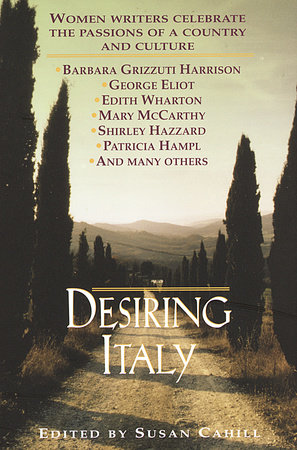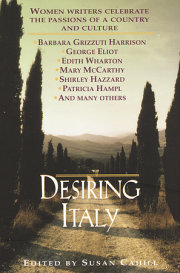Introduction
Italy pleasures more visitors than any other country in Europe. Enchanted travelers, male and female, come home to report her blisses, yearning only to return. They seduce their listeners with the particularities of the beloved’s sensuality: Tuscany, Titian, Café Sant’Eustachio, paglia e fieno deliciosa. As memories flow, new journeys are conceived.
Writers have been declaring their love of Italian cities, art, and people for centuries—Goethe, Stendhal, Byron, Shelley, Dickens, Robert Browning, Ruskin, Henry James, and D. H. Lawrence are the best known. But still to be heard are the stories of women’s passions for Italy. As writers of travel essays, memoirs, and fiction, as exiles, pilgrims, and pioneers of one sort or another, they have, from multiple points of view in widely varying tones, had their say. Desiring Italy gathers together their best testimonies—beautiful mixtures of affection, intelligence, and wit. Few write simply as tourists, as one-trip reporters. Each woman has found there a world of art or love, of personal meaning—an encounter of such profound interest she must tell it.
If there is a unifying theme, it may be an intuition and embrace of the wholeness of life in Italy. Instead of the divorce between body and spirit, the secular and the sacred that alienates the more Protestant ethos of northern countries (and climates), in Italy physical and spiritual experience feels like one vibrant continuum. Perhaps it is the liberating humor of this acceptance of complexities and contradictions that intrigues and pleases women. Perhaps it is the pleasure that quickens the daily ordinary: the eating, the caring for children, the passeggiata. Sexual experience, masculine and feminine, seems like an embodied fact of life—a mixed, mysterious blessing—rather than polarized modes of discourse or problems to be solved. No wonder the many women who’ve come to Italy and chosen to stay for good.
How have women writers remembered the joy of their times in Italy? Why are travelers so often happy here? Can the lover explain the mystery of the beloved?
The writer guides in this book reveal the resonant subtleties of real places and imperfect people. In fiction and nonfiction, they describe coming to understand something significant about a place. For some (Mary McCarthy in Florence, Edith Wharton in Milan), it is Italy’s prominence in the world of architecture; for others (Patricia Hampl in Assisi, Florence Nightingale in Rome), it is Italy as the setting of a passionate religious experience. One woman defines her decision to stay in Italy, to work here and not return to America, as “a renunciation of rigidity.” A few others, charmed by her sheer physicality and sociability, write stories of erotic love as memory (Edith Wharton’s “Roman Fever”), as aesthetic possibility (Elizabeth Spencer’s “The White Azalea” and Francine Prose’s “Cauliflower Heads”), or as romantic dream (Elizabeth von Arnim’s The Enchanted April, in which sunny Portofino on the Italian Riviera represents the fertile core of love and its paradisial transformations). As William Zinsser said in They Went: The Art and Craft of Travel Writing, “Some of the best travel writing turns up in novels and short stories.”
Collectively, all the pieces serve a double purpose: first, as a brilliant literary companion for readers; and second, as a guide for travelers to the particular places described within each selection. Following each selection is a commentary to help the traveler connect as fully as possible with the individual writer’s sense of a particular place. I have visited the places named and evoked in all the writings. Following Mary McCarthy through Brunelleschi’s Florence and walking George Eliot’s and Elizabeth Bowen’s Rome and Mary Shelley’s Venice, to mention only a few examples, gave me an unforgettable portion of their delight. My travels also enabled me to see for myself, with map in hand, how closely their descriptions and references match the places and settings as they are today. That became the focus of each commentary—helping the traveling reader situate herself along the writers’ routes and within their personal context.
I’ve also elaborated on aspects of places that especially concern the cultural history of women. For example, Muriel Spark’s travel essay on Venice praises Titian’s painting of the Assumption in the Frari; my comments address the significance of the feast of the Assumption of Mary within contemporary feminist spirituality. Mary Taylor Simeti’s excursion to Enna in Sicily has as its background the myth of Persephone and Demeter and the importance of the Goddess to contemporary women, subjects which I discuss. Women’s resistance to fascism during World War II is relevant to the selections from the autobiographical narratives by Iris Origo.
Not only the cultural focus of many writings suggests a woman’s perspective or special interest. The women writers who love Italy also take a different tone from what we hear in the travel notebooks of Dickens, Hawthorne, or Henry James. The women’s narratives come across with a down-to-earth concreteness. They’re irreverent, critical, and anecdotal, but they are never brittle, mean-spirited, or smug at the Italians’ expense. Italian religion is never (or almost never) dismissed as superstition or the Italians’ warmth as crudeness. No narrator observes safely from a cool, all-knowing, aesthetic distance. Rather, their affection for the place and people moves the current of their prose.
The snobbery heard from many travel writers and travelers on the subject of the Mezzogiorno, as Southern Italy is called, does not trouble the women writers who love the South. (That’s not to say you don’t have to watch whatever’s snatchable, as everyone must in any poor place.) But despite the petty crime, seeing the South through the eyes of unpuritanical writers (Shirley Hazzard, Rose Macaulay, Ann Cornelisen, Barbara Grizzuti Harrison, and Mary Taylor Simeti), as I have done on my most recent visit, is a revelation: Italy’s Southern face, her most hidden, varied, and ancient expression—Greek, Roman, Byzantine, Arabic, African, Norman, Spanish—is astonishingly beautiful and handsome, a disturbing and haunting memory.
Often, though, the writer/traveler finds, not the exotic, but the common and ordinary to be the richest and most fascinating territory. Eleanor Clark’s attention is on the communal spaces of Rome: she leads us around Roman fountains and their piazzas. Muriel Spark’s and Marcella Hazan’s Venice presents the pleasures of walking the canals and campos—the neighborhood hangouts of local people—and of cooking, marketing, and snacking at a bacaro. Theirs is a different take from the hallucinatory effect of Byron’s Venice or that of the phobic William Dean Howells, America’s Venetian ambassador in the nineteenth century. Whereas James Boswell dismissed Siena as a boring, “tedious” act, Kate Simon, who is no wide-eyed cheerleader among travel writers, walks us through a hill city of surprises, foolishness, and luminous Sienese beauty. Even her interest in the signs of Tuscany’s Etruscan past comes across as more easy-going than D. H. Lawrence’s furious (but wonderful) Etruscan Places.
This love for the spaces of community (markets, piazzas, churches) over more individualistic pursuits has its consequence: an acceptance—at times, delighted—of human imperfection, a fact of Italian life and character. With their capacious spirits and the courage of their contradictions, the writers in this book look directly but never censoriously at the excesses and omissions of Italian ways. Accordingly, the names of these writers belong to the finest tradition of American and British women’s nonfiction and fiction: George Eliot, Mary Shelley, Edith Wharton, Elizabeth Bowen, Mary McCarthy, Francine Prose.
The travel sections of bookstores are well stocked with the regularly reprinted editions of travel essays by Goethe, Lawrence, and William Dean Howells. A literary companion to Italy from the points of view of first-rate women writers/travelers serves to particularize our sense of the country. Women writers have something different to tell us or they tell their stories in a different key. For a number of women, both historical and fictional, represented in this book, Italy is the destination and the journey itself, a familiar metaphor for the life-long pilgrimage toward the self’s interior. The place and the process act together as a sort of double catalyst; a change of heart is a strong motif of the Italian experience. The autobiographical slant of such travel writing is clear. And when Elizabeth Bowen in A Time in Rome names as one of the desires of her journey “a liberation from the thicket of the self,” there is no contradiction between the traveler’s search for and invention of self and her exhilirating sense of freedom from its constrictions. Both are dimensions of the self’s story that Italy lets play. In a few cases, the women’s writings are forgotten (Francesca Alexander’s Roadside Songs of Tuscany) or hard to find (Iris Origo’s extraordinary war diary, War in Val D’Orcia). Once discovered, however (and followed on foot, by car, and on the train), the well-known and unfamiliar writers of Desiring Italy amply reward the curious and the adventurous, resonating as deeply with present-day lovers of Italy as the widely quoted opinions of, say, John Ruskin. Having their impressions of Europe’s ancient heart and soul in one volume serves all traveling readers who desire the company of uncommon witnesses.
Copyright © 2011 by Edited by Susan Cahill. All rights reserved. No part of this excerpt may be reproduced or reprinted without permission in writing from the publisher.






